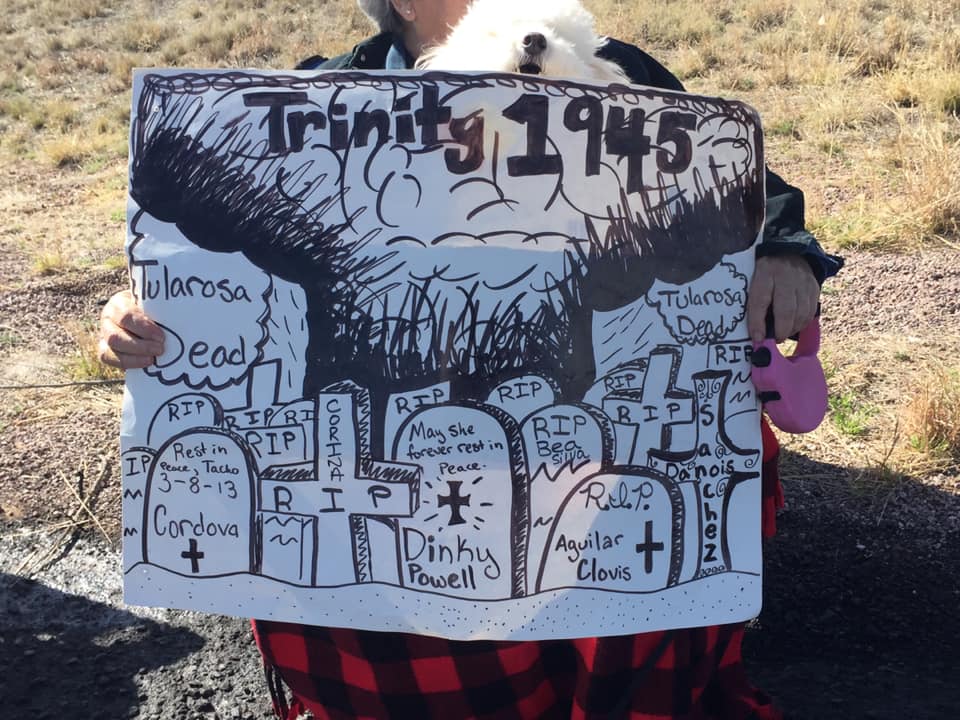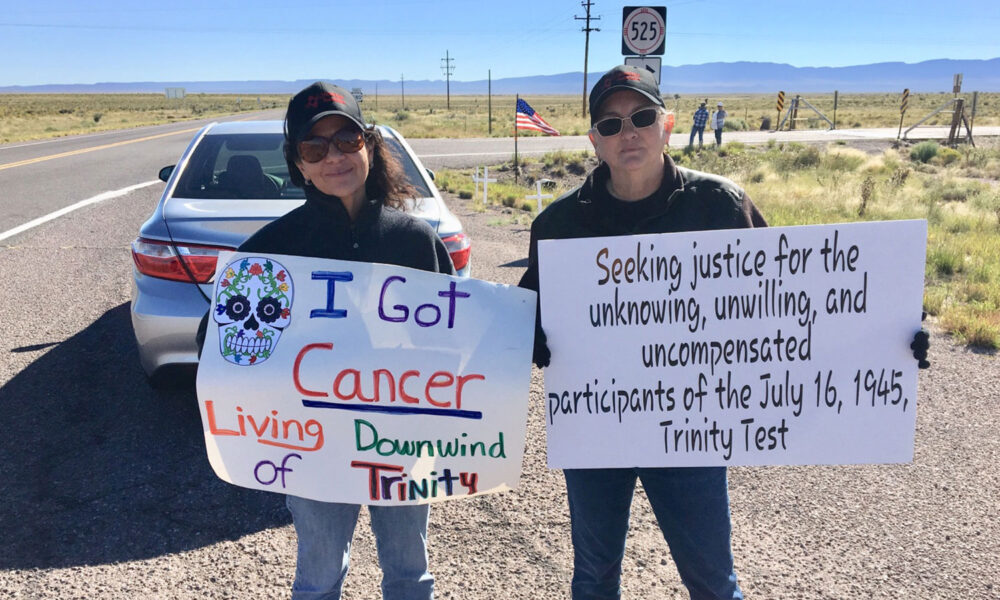There’s no question that the US government killed and sickened many of its own people through explosive nuclear testing: estimates of the death toll in the United States from nuclear testing vary widely, from tens of thousands to hundreds of thousands. But the harm doesn’t stop there. Other nuclear weapons activities, like uranium mining, production, and waste storage and cleanup, have also caused unknown deaths and illnesses. As is so often the case, the people who have borne the heaviest burden of these activities are often people of color, Indigenous communities, women and children, and those living in poor, rural communities. These people are the largely ignored, often forgotten casualties of the Cold War and the US nuclear weapons program.
In 2011, the Senate voted unanimously to designate January 27th as “a national day of remembrance for Americans who, during the Cold War, worked and lived downwind from nuclear testing sites and were adversely affected by the radiation exposure generated by the above ground nuclear weapons testing.” This was long overdue: between 1945 and 1992 the United States conducted over 1,000 nuclear weapons tests, and 216 of them were above ground or under water. These tests spread radioactive fallout across the entire country.
The science behind nuclear weapons harm
Scientific studies on the impacts of these activities are generally too few and too late. In large part, the government neglected to adequately monitor radiation fallout and exposure at the time. When that data did exist, or when concerns of harm were raised, it was often actively suppressed by the government out of fear of liability, and that it would shed a negative light on nuclear weapons development. All of this means that when studies have been attempted, decades later, it is extremely challenging to get accurate data on exposure and health outcomes. But even still, the research and studies that are available paint a clear picture of harm. For example:

County exposure levels to Iodine 131 from a 1997 study carried out by the National Cancer Institute. Some of the highest exposure levels in the country were in Idaho and Montana, hundreds of miles from the Nevada Test Site. National Institute of Health.
- In 1950, before testing began at the Nevada Test Site, government officials met to discuss anticipated safety issues, and acknowledged that people downwind of the tests would likely be exposed to more radiation than was considered medically safe. In 1984 a federal court ruled that the US government had been negligent in monitoring exposure and protecting those downwind.
- A 1997 study from the National Cancer Institute (NCI) estimated that testing at the Nevada Test Site could have caused between 11,000 and 212,000 thyroid cancer cases. Bear in mind that this study looked only at thyroid cancer caused by Iodine 131 (I-131), not at any other illnesses known to be caused by I-131 or any other radioactive contaminants.
- A study completed in 2020 shows that the 1945 New Mexico Trinity Test (the first nuclear weapons test ever completed) alone likely caused up to 1,000 cancer cases. A recent study also shows a sharp spike in infant mortality linked to the test.
- Studies since the 1930s have demonstrated a clear link between cancers and other deadly illnesses from exposure to radon and other hazardous metals and chemicals found in uranium mines and mills. In the 1960s, numerous studies specifically on US uranium miners clearly demonstrated increased illnesses and deaths linked to chronic radiation exposure.
- In 1980, a Centers for Disease Control study on the health of veterans involved in atmospheric testing showed drastically higher rates of leukemia compared to other servicemembers.
- There are innumerable studies connecting radiation exposure to cancer and other illnesses, including a lifespan study on the survivors of the bombings in Hiroshima and Nagasaki.
Beyond the science available, every community involved in the nuclear weapons industrial complex can share story after story after story of crushing illnesses, whole families devastated by cancer, and “Death Miles” – streets or neighborhoods lined with cancer cases and deaths. For years these communities, lacking proper studies and support from the government, have conducted community health studies and compiled lists of their lost loved ones.
In light of this incredible harm, the US government has an obligation to do more than simply recognize that harm. They need to offer those communities compensation and health care for the cancers and other illnesses they continue to suffer. One way to do this is through the Radiation Exposure Compensation Act, or RECA.
What is the Radiation Exposure Compensation Act?
RECA is a federal program that provides lump sum compensation to individuals with illnesses caused by nuclear weapons activities. Individuals from three groups can apply:
- Uranium miners, millers, and ore transporters who worked in the uranium industry from 1942 to 1971 are eligible for $100,000.
- “Onsite participants” of atmospheric nuclear weapons tests (these can be either military servicemembers or civilian contractors employed at US nuclear weapons test sites) are eligible for $75,000.
- Downwinders (individuals who lived downwind of the Nevada Test Site) are eligible for $50,000.
RECA also provides funding for local health centers and nonprofit organizations to conduct cancer screenings and support individuals in filing RECA claims. Anyone applying must have a specific compensable disease and have worked or lived in a designated location for a specific period of time.
RECA was established in 1990 and expanded slightly in 1992 and 2000. As of January 2021, RECA has paid out roughly $2.44 billion to 37,757 individuals. This is a tiny drop in a very large bucket of nuclear spending. By comparison, Stephen Schwartz, author of Atomic Audit, has estimated that the US has spent at least $1.2 trillion on its nuclear weapons arsenal and related programs since 1990.

Geographic areas currently covered by the Radiation Exposure Compensation Act. Many exposed communities are excluded and are fighting to expand coverage. Department of Justice.
Extending and expanding RECA
RECA is a valuable program, and its enactment was a huge step towards justice for those harmed. But it still has major flaws. Many highly exposed communities are still excluded from RECA. The amount of compensation has been unchanged over the past 30 years despite inflation, and even in 1990 did not go very far towards covering health care costs for cancer treatment. Perhaps most significantly, RECA is set to expire in July 2022. This cannot be allowed to happen. Because of these major concerns, members of impacted communities have urged their members of Congress to introduce legislation to expand and extend RECA.
The most expansive of these bills (H.R. 3783) was introduced in 2019 in the House of Representatives. Here are the main ways that legislation would improve the program:
- Extend RECA to 2045.
- Expand downwinder eligibility areas to include Idaho, Montana, New Mexico, Guam, and Colorado, which received high levels of radiation, and expand coverage in existing downwinder states of Utah, Nevada, and Arizona.
- Expand uranium worker eligibility to include:
- Those who worked in the uranium industry from 1971 to 1990. Currently, thousands of uranium workers who worked in the mines after 1971 are excluded from applying for compensation.
- Uranium core drillers and those involved in remediation efforts of uranium mines or mills.
- Additional compensable diseases
- Expand eligibility to participants involved in the cleanup mission in Enewetak Atoll of the Marshall Islands from 1977-1981.
- Increase the lump-sum compensation amount to $150,000 for all claimants, and allow people who had previously received RECA compensation in the past to receive the full $150,000.
- Allow those exposed to atmospheric testing to receive the same medical benefits available to Department of Energy workers who are eligible for coverage under the Energy Employees Occupational Illness Compensation Program Act.
These improvements to RECA are decades overdue. The NCI study revealing I-131 exposures in states like Idaho and Montana was released 23 years ago, after being actively suppressed by the government for 5 years. A National Academies of Science report recommending Guam be included in RECA was released 15 years ago. Communities like the Trinity Test Downwinders and Post-71 Uranium Workers have been fighting for inclusion in RECA for nearly 15 years. Over these years, many have suffered and died waiting for compensation. Survivors often feel that the government is simply waiting for them to die so that they won’t have to take responsibility for the harms they caused.
Supporting frontline communities

Peaceful Demonstration with Trinity Downwinders at the Trinity Site Open House in New Mexico. Tularosa Basin Downwinders Consortium.
A day of recognition is important – these communities deserve to be recognized for the unimaginable sacrifice they unknowingly made to their country. But it is not enough. The best and most important way to honor these victims of the US nuclear weapons program is by compensating them and providing health care for the illnesses and deaths they have suffered. You can help: tell your members of Congress that they must extend and expand RECA and by doing so, take a step towards providing just care and compensation to all communities harmed by nuclear weapons activities.
There are many incredible grassroots advocacy groups that have been leading this work for years. We encourage you to learn more about their crucial work and support them:
- Atomic Cleanup Vets (National)
- Concerned Citizens for Nuclear Safety (NM)
- Downwinders Inc (UT)
- Idaho Downwinders (ID)
- Multicultural Alliance for a Safe Environment (NM)
- National Association of Atomic Veterans (National)
- Pacific Association for Radiation Survivors (Guam)
- Tularosa Basin Downwinders Consortium (NM)
Image caption: Peaceful Demonstration with Trinity Downwinders at the Trinity Site Open House in New Mexico, ( L-R): Tina Cordova and Laura Greenwood. Trinity downwinders have been fighting for inclusion in the Radiation Exposure Compensation Act for over 15 years.
The featured image in this blog is courtesy of the Tularosa Basin Downwinders Consortium.

